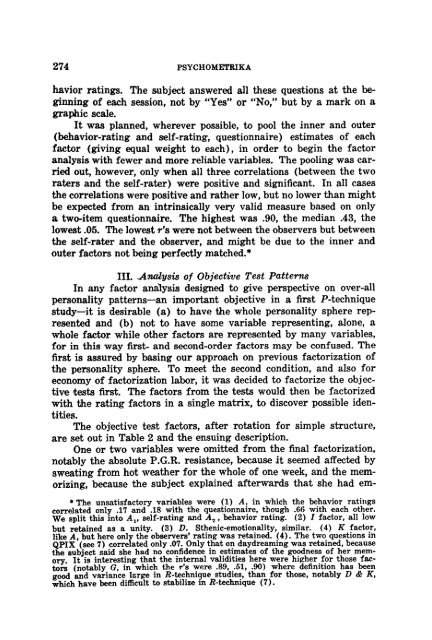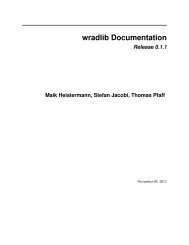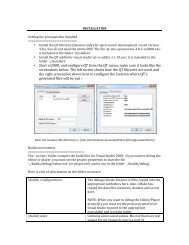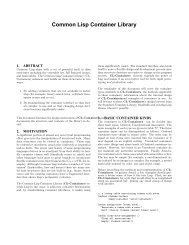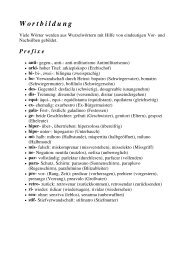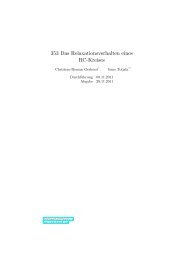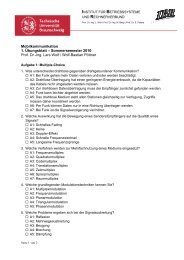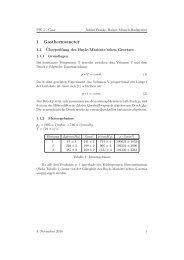P-Technique Demonstrated in Determining ... - Bitbucket
P-Technique Demonstrated in Determining ... - Bitbucket
P-Technique Demonstrated in Determining ... - Bitbucket
Create successful ePaper yourself
Turn your PDF publications into a flip-book with our unique Google optimized e-Paper software.
274 PSYCHOMETRIKA<br />
havior rat<strong>in</strong>gs. The subject answered all these questions at the beg<strong>in</strong>n<strong>in</strong>g<br />
of each session, not by "Yes" or "No," but by a mark on a<br />
graphic scale.<br />
It was planned, wherever possible, to pool the <strong>in</strong>ner and outer<br />
(behavior-rat<strong>in</strong>g and self-rat<strong>in</strong>g, questionnaire) estimates of each<br />
factor (giv<strong>in</strong>g equal weight to each), <strong>in</strong> order to beg<strong>in</strong> the factor<br />
analysis with fewer and more reliable variables. The pool<strong>in</strong>g was cartied<br />
out, however, only when all three correlations (between the two<br />
raters and the self-rater) were positive and significant. In all cases<br />
the correlations were positive and rather low, but no lower than might<br />
be expected from an <strong>in</strong>tr<strong>in</strong>sically very valid measure based on only<br />
a two-item questionnaire. The highest was .90, the median .43, the<br />
lowest .05. The lowest r's were not between the observers but between<br />
the self-rater and the observer, and might be due to the <strong>in</strong>ner and<br />
outer factors not be<strong>in</strong>g perfectly matched.*<br />
IIL .,4naJysis of Obyective Test Patterns<br />
In any factor analysis designed to give perspective on over-all<br />
personality patterns--an important objective <strong>in</strong> a first P-technique<br />
study--it is desirable (a) to have the whole personality sphere represented<br />
and (b) not to have some variable represent<strong>in</strong>g, alone, a<br />
whole factor while other factors are represented by many variables,<br />
for <strong>in</strong> this way first- and second-order factors may be confused. The<br />
first is assured by bas<strong>in</strong>g our approach on previous factorization of<br />
the personality sphere. To meet the second condition, and also for<br />
economy of factorization labor, it was decided to factorize the objective<br />
~sts first. The factors from the tests would then be factorized<br />
with the rat<strong>in</strong>g factors <strong>in</strong> a s<strong>in</strong>gle matrix, to discover possible identities.<br />
The objective test factors, after rotation for simple structure,<br />
are set out <strong>in</strong> Table 2 and the ensu<strong>in</strong>g description.<br />
One or two variables were omitted from the f<strong>in</strong>al factorization,<br />
notably the absolute P.G.R. resistance, because ~t seemed affected by<br />
sweat<strong>in</strong>g from hot weather for the whole of one week, and the memoriz<strong>in</strong>g,<br />
because the subject expla<strong>in</strong>ed afterwards that she had em-<br />
* The unsatisfactory variables were (1) A, <strong>in</strong> which the behavior rat<strong>in</strong>gs<br />
correlated only .17 and .18 with the questionnaire, though .66 with each other.<br />
We split this <strong>in</strong>to A 1, self-rat<strong>in</strong>g and A~, behavior rat<strong>in</strong>g. (2) I factor, all low<br />
but reta<strong>in</strong>ed as a unity. (3) D. Sthenic-emotionality, similar. (4) K factor,<br />
like A, but here only the observers' rat<strong>in</strong>g was reta<strong>in</strong>ed. (4). The two questions <strong>in</strong><br />
QPIX (see 7) correlated only .07. Only that on daydream<strong>in</strong>g was reta<strong>in</strong>ed, because<br />
the subject said she had no confidence <strong>in</strong> estimates of the goodness of her memory.<br />
It is <strong>in</strong>terest<strong>in</strong>g that the <strong>in</strong>ternal validities here were higher for those factors<br />
(notably G, <strong>in</strong> which the r's were .89, .51, .90) where def<strong>in</strong>ition has been<br />
good and variance large <strong>in</strong> R-~chniquestudies, than for those, notably D & K,<br />
which have been difficult to smoiiize <strong>in</strong> ~-zecnnique t'~J.


